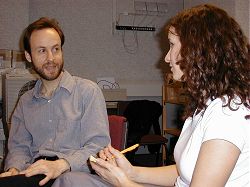|
Temple/London
Fall 1999 |
|
|
Temple/London
Fall 1999 |
|
Form:
Presence
by
C. Leight and M. Wilson
The Question
Presence in the media can be defined as the illusion of an unmediated experience. To create the illusion of an unmediated experience, different elements can be manipulated. The media can use a number of techniques to create a new reality so the viewer can have the most inviting experience. This research compared the effectiveness of presence in Britain and the United States and looked at the ways in which a sense of presence can be achieved.
Method:
The question was primarily analyzed by conducting a series of interviews: 1.) a university professor, Matthew Lombard who researches presence, 2.) Brendon DeVore, a video game enthusiast and a student studying media and 3.) various students who are familiar with the media in Britain and the U.S. The interviews with the students and the professor were conducted in a classroom, and the interview with DeVore was conducted in London’s "Tracadero", a multimedia entertainment complex.

Results:
The findings suggested that presence is manipulated quite differently in the two countries. Matthew Lombard, a university professor and researcher of presence, noted that the use of presence on T.V. in Britain might actually be more effective. Lombard observed that "British programs use fewer logos, commercials and clutter than in the U.S. which leads to fewer opportunities for the viewer to realize that he or she is watching a television show." In addition Lombard mentioned that the television shows in Britain, regardless of whether they are filmed inside Parliament or on a stage, rarely announce or give any indication by using a logo in a corner of the screen, to inform that they are live or taped. Instead, the viewer is left to make the determination. The U.S., however, almost always has an indicator when a program is live so viewers assume that when it is absent the program is not live. The programming in Britain is less sophisticated. The news often appears unedited, and there are fewer graphics on the screen. This actually leads to an increased sense of presence by making it seem more genuine.
Other dimensions of presence were studied by comparing the IMAX theaters and interactive games in Britain and America. Five students from the U.S. who have experienced IMAX in both countries overwhelmingly favored the one in Britain. Many of them attributed the success of the BFI IMAX cinema, which the entire class visited, to the lightweight glasses. American versions of IMAX often require the viewer to wear heavy and somewhat cumbersome goggles that distract from the experience.
The quality of presence in video games also differed in the two countries. Video game enthusiast Brendon DeVore visited Sega World in the London Tracadero accompanied by the researchers. He decided that based on his extensive knowledge of games in both countries, Britain’s versions were more realistic; for instance, the racecar game took place in a vehicle resembling a car. When turning a corner or driving off road the seat jerked, making him feel as though he were really moving. A camera situated in the corner allowed him to see the faces of himself and the other racers. DeVore explained that the games in the states are less sophisticated and the fact that it is just a game is more obvious. DeVore also marveled at the James Bond game in Sega World, which combined a story, and a game. The action took place in the first-person making him feel as though he was really there, he was able to see his hand in the screen in front of him and the characters spoke to him, with each comment dependent upon the choices that he made.
Conclusions
Although this study offers only a glimpse into the manipulation of presence in the two countries, further and more extensive research could offer a more comprehensive view of the phenomenon. The way in which the media uses presence is important to the viewer’s experience, but there are also factors that the viewer himself can control such as the size of the television, etc. Since it influences how the viewer interprets what he sees, presence and its psychological effects deserve attention from both psychologists and media researchers.
Sources/For More Information:
![]()